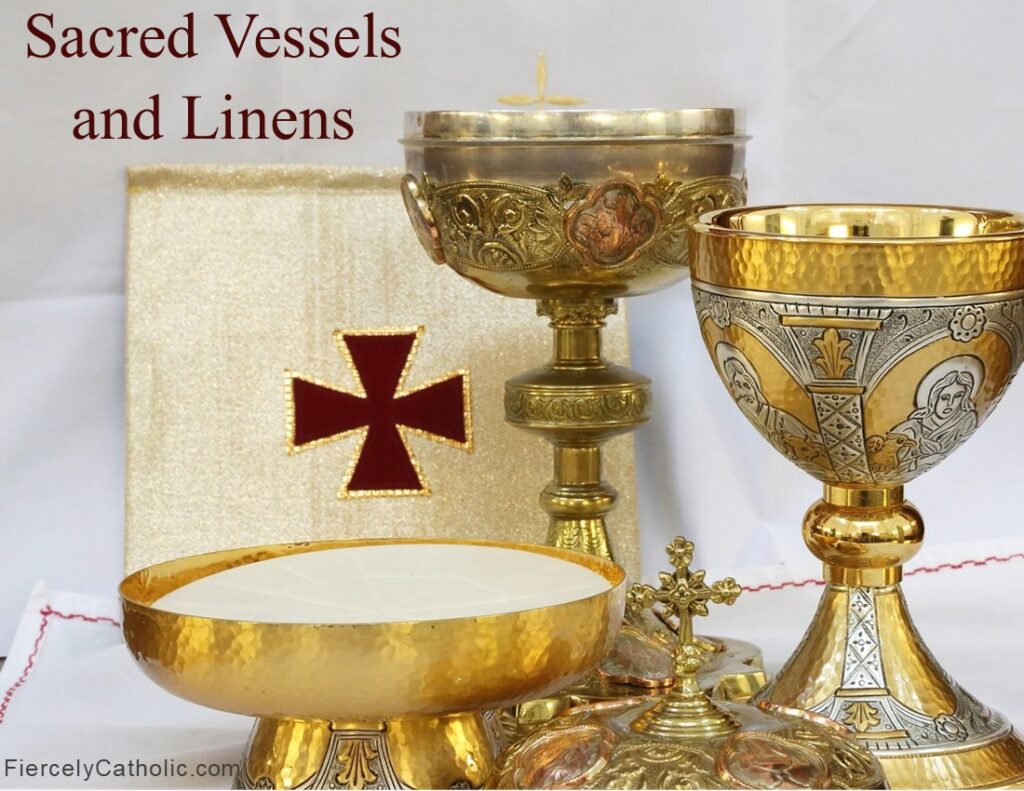
At a Catholic Mass, the priest uses sacred containers and utensils that are set apart for liturgical use. Distinguished from items intended for everyday use, they are treated with special care and reverence because of the purpose the serve.
These sacred vessels are ornately designed and made of precious metals, like gold or silver, to respect the dignity of the consecrated Body and Blood of Christ which they hold. They are sturdily constructed so that they will not easily break.
If the sacred vessels are not constructed of precious metal, the inside must be lined with silver or gold.
Held in special honor is the chalice which holds the Precious Blood of Jesus. Wine is mixed with a few drops of water in this large cup and then consecrated by the priest. Its name comes from the Latin word calyx, which means “cup”.
Smaller, less ornate cups are used to distribute the Precious Blood to the congregation.
From the Latin word for plate, the paten is circular dish or shallow bowl that holds the single large host that the priest offers to God and which will become the Body of Christ.
A larger, bowl-shaped container with a tight-fitting lid is called a ciborium. The ciborium holds the smaller consecrated hosts to be received by the Catholic faithful. The ciborium will also hold the consecrated hosts that are reserved in the tabernacle until the next Mass.
Preparing for Holy Communion, the sacred vessels are placed on a corporal, a square piece of fine white linen that is unfolded and placed on top of the altar to catch any particles of the Body or Blood. The name of the corporal reflects that the Body of Christ will lie on it.
The purificator is s smaller cloth of fine white linen used to wipe the chalice to prevent the Precious Blood from dripping to the ground. The purificator is also used to clean the sacred vessels after Holy Communion.
To keep dust or insects from contaminating the Precious Blood, the chalice is covered by a stiff square of linen called a pall.
Water and wine to be used at Mass are held in small cruets which are not required to be made of precious metal. A towel and small bowl called a lavabo is used for the priest to cleanse and dry his fingers.
Before Mass, the chalice, purificator, paten, and pall may be completely covered by a veil that matches the liturgical color of the priest’s vestments.
After Holy Communion, the priest or deacon purifies the sacred vessels, rinsing them and consuming the water so that none of the Body or Blood of Jesus is desecrated. The corporal is carefully refolded and the veil put back in place.
When Mass has ended, the vessels are more thoroughly cleaned and the purificator is rinsed at the sacrarium, a special sink that drains directly into the ground. The vessels are then stored in the sacristy.
Holy vessels for an ongoing sacrifice:
What the priest uses on the altar at Mass:
Treating the Body and Blood of Christ with reverence:
All the people of Israel assembled before King Solomon during the festival in the month of Ethanim (the seventh month). When all the elders of Israel had arrived, the priests took up the ark; and they brought up the ark of the LORD and the tent of meeting with all the sacred vessels that were in the tent. The priests and Levites brought them up.
1 Kings 8: 2-4
Vessels and linens of significance:
Designed for liturgical use:
Everything related to the Eucharist should be marked by beauty. Special respect and care must also be given to the vestments, the furnishings and the sacred vessels, so that by their harmonious and orderly arrangement they will foster awe for the mystery of God, manifest the unity of the faith and strengthen devotion.
Pope Benedict XVI, Sacamentum Caritatis, 22 February 2007
Sacred vessels for the most sacred things:
Using the sacred vessels to prepare the gifts:
The presentation of the offerings (the Offertory). Then, sometimes in procession, the bread and wine are brought to the altar; they will be offered by the priest in the name of Christ in the Eucharistic sacrifice in which they will become his Body and Blood. It is the very action of Christ at the Last Supper – “taking the bread and a cup.” “The Church alone offers this pure oblation to the Creator, when she offers what comes forth from his creation with thanksgiving.” The presentation of the offerings at the altar takes up the gesture of Melchizedek and commits the Creator’s gifts into the hands of Christ Who, in his sacrifice, brings to perfection all human attempts to offer sacrifices.
Catechism of the Catholic Church 1350
The sacred vessels are purified after Holy Communion:
Sacred vessels are stored in the sacristy:
The Truth, Goodness, and Beauty of the Catholic Church
Every priest has a story behind their first chalice:
Share this page with friends and family to start a conversation about your faith.
Don’t miss a post. Learn more about the Catholic Church and strengthen your Catholic faith.
Find more Fiercely Catholic video issues here.
Subscribe here.


